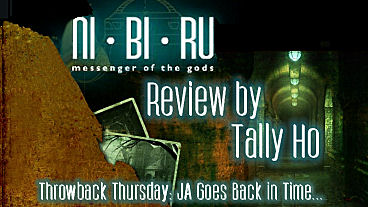
NiBiRu: Messenger of the Gods
From an astonishing secret hidden by the Nazis at the end of WW2 to the heart of Prague and beyond, unlock the secrets of the ancient Mayans





Genre: Sci-Fi / Mystery / Adventure
Release Date: 2005
Platform: PC
Alternate Title (N. America): NiBiRu: Age of Secrets
Note: Originally published 28 June 2005
NiBiRu is the name given to the mythological twelfth planet of our Solar System, and its projected return in the 21st century has sparked some interesting debates over the years (For some background material visit the following sites:Is it Approaching? – What Happened?).
All of this theory is – in my humble opinion – nonsense, but very entertaining nonsense nevertheless. Now the game’s title would naturally have one anticipating something with a bit of a Sci-Fi twist. Not so. Yes, the 12th planet is mentioned briefly, but – as concerns the game – it seems that the Germans – including the Führer himself, who wrote about the phenomena in his Diary – were onto the story in the 1930’s. Our protagonist will stumble upon the book decades later, in a secret room buried deep down in a complex tunnel. It’s all part of his quest to retrieve some artifacts in order to solve the mysterious story. Incidentally, this game was released in 1998 under the title of Posel Bohu – but only in Czechoslovakian. The storyline in the new release is identical, but the game engine, graphics and voice acting have been completely overhauled. This time around, they have realized the value of multi-lingual releases and have developed French, German, Italian, Russian and English versions. The English version is expected from Dreamcatcher in October, 2005 (This review is from the German version).
Martin Holan is the name of the game’s hero. You, the gamer, play as Martin in this third-person, point-and-click game. It’s really 2-Dimensional graphics, but drawn in such a way as to make you feel as though you are in a 3-D environment. I like the effect, which you may have already experienced if you played Black Mirror, a game from the same developers. Absolutely stunning graphics combined with a simple, rock-solid interface are factors that contribute to its enjoyability. I really like the feature where the inventory item flashes when it is hovered over the correct place to use it, whether it’s another item in inventory, or a place in the game screen such as a padlock or a lamp. This gimmick has been used previously in Black Mirror. Also worth mentioning is that an inventory item vanishes when it’s no longer needed. This saves a lot of trial and error on the player’s part.
Martin is a student of archeology. The game begins with his uncle, a professor of archeology setting the scene by telling Martin the background story, and sending him on his way to Prague to get some information from a lady named Barbora Kanska. She seems to be hard to find, and that becomes Martin’s first challenge. Along the way, Martin will visit some wonderful locations including Prague, Paris, an old mine somewhere in Germany, and the Mayan ruins. As he makes his way closer to the truth, he needs to accomplish the usual gaming stuff – find the key to unlock the door, distract the secretary or a military guard in order to get past them, oil the rusty thingamajig, etc. all the while gathering clues and information that contribute to the story as a whole.
You’ll run across a bratty little girl who likes to throw firecrackers down from a balcony, security or military guards who stand in the way of Martin’s progress, a fiery Mexican Señora who has ousted her smelly drunken husband and sequestered her single daughter, and a few other archeologists who may or may not be cooperative.
There are very few actual puzzles, (no mazes – wahoo!) but there is one Slider, albeit one with a little different twist. We’ve seen sliders before, where the final blank square is in the center (Sherlock Holmes: Mystery of the Mummy) but this one is tougher because the pieces do not form an integral image when completed. Instead, they are separate Mayan faces, which must be slid atop their matching image which is then revealed each time the empty square is over one of the locations other than the center. Save your game before twiddling with the Slider – it cannot be reset to its original configuration.
The graphics are my cup o’ tea with a strong attention to details. Czech Republic developers Future Games have some great artists on staff, and I can only dish up the highest praise for the visual results. They always achieve the appropriate atmosphere for the moment (It rains somewhat, but not quite as much as it did in Black Mirror – after playing that game I had to check my computer for mildew!). The exterior and interior scenes are consistently magnificent, and you are never left wondering what you are looking at. Only once did the designers slip, when Martin manages to shut down an electric generator in order to slip past someone in the darkness, the programmers left the lights on in one segment of the cutscene, even though the generator was off. (Oops!) Other than that – I found no flaws.
The ambient sounds and active sound effects achieve high marks as they are just what you expect, nothing too much or too little. The music is great and though some gamers might desire a continuous soundtrack, I found the gaps refreshing.
My only complaint is the story itself. Here’s where I have to step back a little, and wish the writers had put forth a better effort. Granted the story “works” – that is, it hangs together and makes sense, but overall, it comes across as a lightweight meandering tale, concocted for the purpose of supporting an adventure game, and not as a story that can stand on its own merit. While they were revamping the 1998 version – which featured cartoony graphics – they should have considered strengthening the plot line somewhat. That said, I would still buy and play this game, and I look forward to another production from this talented team.
Final Grade: B+
System Requirements:
OS: Windows® 95/98/ME/2000/XP
CPU: 800 MHz Pentium® 3 (or comparable)
RAM: 128 MB RAM
Free Hard Disk Space: 2.5 GB
CD/DVD-ROM Drive: 16x
Video: 32 MB DirectX® 3D Compatible Video Card
Sound: DirectX® Compatible Sound Card
Input: Keyboard, Mouse and Speakers

Leave a Reply